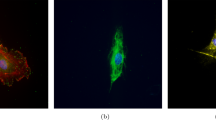Abstract
Endothelial cells, when cultured on gelled basement membrane matrix exert forces of tension through which they deform the matrix and at the same time they aggregate into clusters. The cells eventually form a network of cord-like structures connecting cell aggregates. In this network, almost all of the matrix has been pulled underneath the cell cords and cell clusters. This phenomenon has been proposed as a possible model for the growth and development of planar vascular systems in vitro. Our hypothesis is that the matrix is reorganized and the cellular networks form as a result of traction forces exerted by the cells on the matrix and the latter's elasticity. We construct and analyze a mathematical model based on this hypothesis and examine conditions necessary for the formation of the pattern. We show cell migration is not necessary for pattern formation and that isotropic, strain-stimulated traction is sufficient to form the observed patterns.
Similar content being viewed by others
References
Advani, S. and C. Tucker (1987). The use of tensors to describe and predict fiber orientation in short fiber composites. Journal of rheology 31: 751–784.
Cook, J. (1995). Mathematical Models for Dermal Wound Healing: Wound Contraction and Scar Formation. PhD thesis, University of Washington.
Fung, Y. (1993) Biomechanics. Mechanical Properties of Living Tissues. 2nd ed. Springer Verlag.
Harris, A.K., D. Stopak and P. Wild (1981). Fibroblast traction as a mechanism for collagen morphogenesis. Nature 290: 249.
Harris, A.K., P. Wild and D. Stopak (1980). Silicone rubber substrata: A new wrinkle in the study of cell locomotion. Science 208: 177–179.
Landau, L. and E. Lifschitz (1970). Theory of Elasticity. New York, Pergamon Press.
Lanir, Y. (1983). Constitutive equations for fibrous connective tissues. Journal of Biomechanics 16: 1–12.
Murray, J., G. Oster and A. Harris (1983). A mechanical model for mesenchymal morphogenesis. Journal of Mathematical Biology 17: 125–129.
Poole, T. and J. Coffin (1989). Vasculogenesis and angiogenesis: two distinct morphogenetic mechanisms establish embryonic vascular pattern. Journal of Experimental Zoology, 251: 224–231.
Sage, E. and R. Vernon (1994). Regulation of angiogenesis by extracellular matrix: the growth and glue. Journal of Hypertension 12: 145–152.
Skellam, J. (1973). The formulation and interpretation of mathematical models of diffusionary processes in population biology. In: M. Bartlett and R. Hioms, eds., The Mathematical Theory of the Dynamics of Biological Populations, pp. 63–85. New York, Acad. Press.
Vernon, R., J. Angello, M. Iruela-Arispe, T. Lane and E. Sage (1992). Reorganization of basement membrane matrices by cellular traction promotes the formation of cellular networks in vitro. Laboratory Investigation 31: 120–131.
Vernon, R., S. Lara, C. Drake, M. Iruela-Arispe, J. Angello, C. Little, T. Wight and E. Sage (1995). Organized type I collagen influences endothelial patterns during ‘spontaneous angiogenesis in vitro’: planar cultures as models of vascular development. In Vitro Cellular and Developmental Biology 66: 536–547.
Vernon, R. and E. Sage (1995). Between molecules and morphology: extracellular matrix and the creation of vascular form. American Journal of Pathology 147: 873–883.
Author information
Authors and Affiliations
Rights and permissions
About this article
Cite this article
Manoussaki, D., Lubkin, S.R., Vemon, R.B. et al. A mechanical model for the formation of vascular networks in vitro . Acta Biotheor 44, 271–282 (1996). https://doi.org/10.1007/BF00046533
Published:
Issue Date:
DOI: https://doi.org/10.1007/BF00046533




